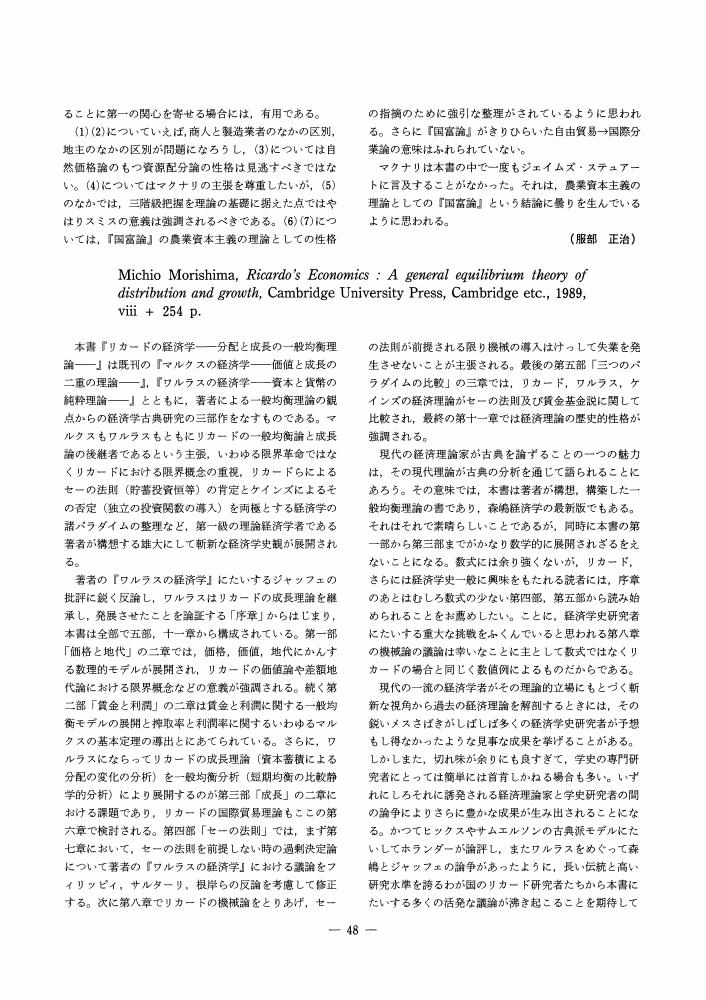8 0 0 0 OA 高田保馬博士と勢力説
- 著者
- 根岸 隆
- 出版者
- 日本学士院
- 雑誌
- 日本學士院紀要 (ISSN:03880036)
- 巻号頁・発行日
- vol.65, no.1, pp.75-91, 2010 (Released:2017-04-05)
6 0 0 0 OA 森嶋通夫教授と投資関数
- 著者
- 根岸 隆
- 出版者
- 日本学士院
- 雑誌
- 日本學士院紀要 (ISSN:03880036)
- 巻号頁・発行日
- vol.62, no.1, pp.81-97, 2007-09
2 0 0 0 OA 均衡の安定性 四十余年後の回顧
- 著者
- 根岸 隆
- 出版者
- 経済学史学会
- 雑誌
- 経済学史学会年報 (ISSN:04534786)
- 巻号頁・発行日
- vol.45, no.45, pp.78-85, 2004 (Released:2010-08-05)
- 参考文献数
- 22
2 0 0 0 OA 安井琢麿教授と一般均衡理論の発展
- 著者
- 根岸 隆
- 出版者
- 日本経済学会
- 雑誌
- 季刊 理論経済学 (ISSN:0557109X)
- 巻号頁・発行日
- vol.23, no.1, pp.19-27, 1972-05-20 (Released:2008-02-28)
1 0 0 0 OA 国際貿易理論史上の二問題
- 著者
- 根岸 隆
- 出版者
- The Japanese Society for the History of Economic Thought
- 雑誌
- 経済学史学会年報 (ISSN:04534786)
- 巻号頁・発行日
- vol.38, no.38, pp.59-65, 2000 (Released:2010-08-05)
- 参考文献数
- 33
Two articles published in the Japanese Economic Review (in English) are summarized as recent examples of my studies in the history of economics. A mathematical model based on the quantity theory of money and the labor value theory of money is constructed in “Japanese Studies of Ricardo's Theory of Foreign Trade” (1996), which can justify Kojima's numerical examples (1951) to insist on the determination of the terms of trade in Ricardian theory. “Unequal Exchange and Exploitation” (1998) denies the possibility of exploitation through international trade, which is insisted by Marx and Marxian economists, by the proper comparison of values differently dated.
- 著者
- 根岸 隆
- 出版者
- The Japanese Society for the History of Economic Thought
- 雑誌
- 経済学史学会年報 (ISSN:04534786)
- 巻号頁・発行日
- vol.28, no.28, pp.48-49, 1990 (Released:2010-08-05)
1 0 0 0 OA マーシャルの部分均衡論と生産者余剰
- 著者
- 根岸 隆
- 出版者
- 東洋英和女学院大学
- 雑誌
- 東洋英和大学院紀要 (ISSN:13497715)
- 巻号頁・発行日
- vol.1, pp.1-12, 2005-04-01
We defended Marshall from modern economic theorists' false accusation that he forgot producers' surplus in his proposition of the tax-subsidy scheme. After due attention is paid to Brahmananda's pioneering contribution, we argued, firstly, that Marshall did not forget producers' surplus but merely considered the case of no producers' surplus, in view of his distinction between the supply curve and the particular expenses curve and the long-run nature of the equilibrium considered. In addition to this purely theoretical vindication (rational reconstruction), we argued further more, from the view point of the history of economic thought, that Marshall did not forget producers' surplus in The Pure Theory, which was aimed at specialist readers, but deliberately assumed it away in Principles, which was aimed at more general readers. Finally, in view of the recent rapid development of the theoretical and applied general equilibrmm theory, we emphasize the role of Marshallian particular equilibrium analysis as a heuristic method.
- 著者
- 根岸 隆
- 出版者
- 関西学院大学
- 雑誌
- 經濟學論究 (ISSN:02868032)
- 巻号頁・発行日
- vol.42, no.3, pp.61-66, 1988-10-15
1 0 0 0 OA 小島清教授と歴史学派
- 著者
- 根岸 隆
- 出版者
- 日本学士院
- 雑誌
- 日本學士院紀要 (ISSN:03880036)
- 巻号頁・発行日
- vol.67, no.2, pp.61-74, 2013-02
1 0 0 0 OA ミルはソーントンに如何に答えるべきであったか (平成一四年一月一五日 提出)
- 著者
- 根岸 隆
- 出版者
- 日本学士院
- 雑誌
- 日本學士院紀要 (ISSN:03880036)
- 巻号頁・発行日
- vol.57, no.1, pp.17-40, 2002 (Released:2007-06-22)
- 参考文献数
- 46
- 被引用文献数
- 1
In Negishi (1986), I developed my view on the so-called Mill's recantation of the wages fund doctrine, the short-run theory of wages in the classical school of the economics. According to a survey article on the recent John Stuart Mill interpretations, “a further twist to the debate has been given by Negishi (1986). He reminds us that Mill, in the 1871 edition of the Principles, retracted some of his earlier enthusiasm for Thornton. There he in effect rejected the idea that disequilibrium trades in any way undermine the importance of the principle of the equality of supply and demand, and cautioned that it was too early to adduce any firm conclusions from the discussion engendered by Thornton's book”(De Marchi, 1988).I have three purposes in this present article. The first one is to offer a Japanese version of Negishi (1986), which I think it worthwhile, since there are still no Japanese translation available of the related literature referred and quoted there, i. e., Thornton (1869), Mill (1869) and Thornton (1870). Secondly, I wish to record the appearance of some related literature published in 1990's, like Ekelund (1997), Forget (1991), Fukagai (1995), Mawatari (1997), Mirowsky (1990), Negishi (1998), Vint (1994), and White (1994). Particularly, I wish to make some detailed rejoinders to comments given by Mawatari (1997).The final one is to consider, from the point of view of the modern economic theory (Arrow and Hahn (1971), pp. 324-346, and Negishi (1972), pp. 207-227), how Mill should have replied to Thornton, who asked the significance of a small amount of trade at equilibrium prices, which are arrived after a great bulk of goods were already sold at disequilibrium prices (Thornton, 1869, pp. 53-54; 1870, p. 65). As is easily seen at a glance at Figures 6, 7 and 8 in the text of the present article, i. e., those of box diagram and of utility frontier, the importance of the final small amount of trade at equilibrium prices is that the Pareto optimality is assured.
1 0 0 0 チューネンはなにを最大化したのか?
- 著者
- 根岸 隆
- 出版者
- 日本學士院
- 雑誌
- 日本學士院紀要 (ISSN:03880036)
- 巻号頁・発行日
- vol.59, no.3, pp.199-210, 2005-03







